Google’s Pixel 7 Still Has the Best Smartphone Camera
The world of Android looks different than when I started focusing on this platform over ten years ago. Gone are the days of Google focusing on its developer-centric devices, allowing other manufacturers to compete for the top spot. If you look around the U.S. market, Android seems to have developed a homogeny akin to that of Apple’s iPhone. If you’re choosing a flagship Android smartphone, it’s now between Google and Samsung—maybe OnePlus if you’re sick of the status quo and know an alternative exists.
The Google Pixel exists as a specific flavor of Android, just the way Samsung’s rolled with it all this time. You’re not getting a stock version of the operating system anymore: you’re getting a version of Android made in Google’s image, complete with Material You stylings and exclusive feature drops. The idea is that if you choose this path, you have perks. Pixels now include robotic help with customer service via Direct My Call and AI magic for unblurring old photos. They also include the most up-to-date software updates directly from the steward of the operating system itself.
This is an excellent strategy for Google to convince buyers that it’s the right path. But I can’t help feeling like it’s a devolution because it’s introduced a new type of fragmentation to an already disparate platform. The Pixel smartphone series exists to showcase Google’s prowess in AI processing, so it’s tuned with a batch of specially-made features. But that leaves other Android users in the dust since those abilities are only usable with the hardware inside Pixel phones.
Let’s make this clear: if you’re looking at the Pixel 7 and Pixel 7 Pro as your next smartphone, it’s because you want the camera capabilities—not the exclusive software features. I’ve been on a non-Pixel device for the last two years, and the thing I missed most was not the ability to have Google answer my phone calls—a feature still limited to Pixel devices—but its camera algorithms. The Pixel 7 and Pixel 7 Pro are still the best smartphone cameras for under $1000.
Google Pixel 7 Specs & Features
Don’t expect record-breaking performance.
To be honest—and this is not a slight on the designers of the Pixel smartphone, who I’m sure gave their heart and soul to reconfiguring the Pixel’s overall design—I’m not a fan of the Pixel’s stylings of late. The camera bar is a better solution than the awkwardness of a side-camera array, which leaves the phone crooked when it’s lying down, but the rest of what’s going on just isn’t vibing with me.
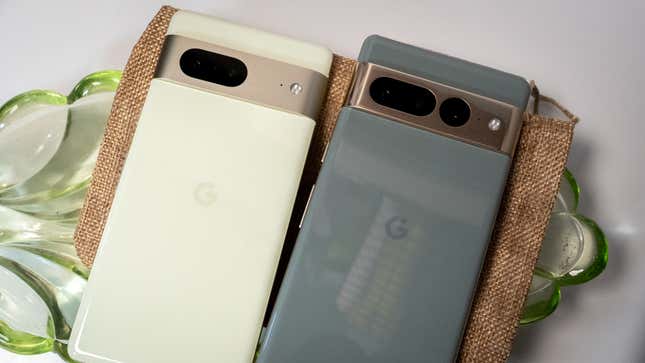
That said, I am enjoying the Pixel 7’s color options more than last year’s Pixel 6/6 Pro, making the rest of the design more palatable. The Lemongrass colorway on the Pixel 7 is a gorgeous lime in person, while the Pixel 7 Pro comes in Hazel, which looks like a grown-up green. The camera bar has also eschewed the blackout look for brushed aluminum, and the camera sensors are more pronounced as modules within the bar. Like the iPhone 14 Pro’s rear camera square, the idea is to immediately draw your attention to the device’s camera capabilities.
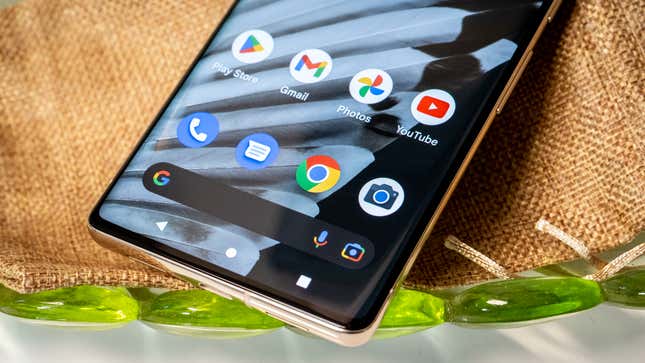
Annoyingly, the Pixel 7 and Pixel 7 Pro are still as slippery as ever. I had to catch the Pixel 7 Pro and Pixel 6 Pro from sliding off my desk once I started writing this section, indicating that not much has changed. If you buy this phone, get a case immediately—something with more grip than the naked phone offers.
The Pixel 7 and Pixel 6 look virtually identical from the front side. The 6.3-inch display on the Pixel 7 and the 6.7-inch display on the Pixel 7 Pro take up most of the chassis, with thin bezels around the frame. It’s well-paired with Material You, and you can see Google’s design language shine through the package. The side power and volume buttons protrude and are easy to press, even with a case.
In terms of size, the Pixel 7 will be a better wield for smaller hands. But the Pixel 7 Pro isn’t untenable. I was surprised at my ability to secure the Pro without the aid of a pop socket.
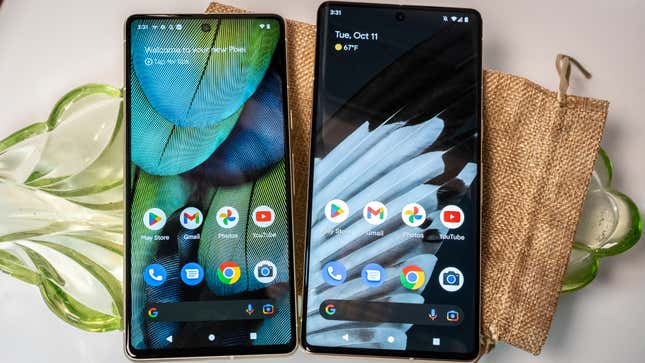
Google Pixel 7 Screen
A new, old way to unlock your phone.
There are differences between the Pixel 7 and Pixel 7 Pro’s displays besides the size. The Pixel 7 has a maximum refresh rate of 90 Hz, while the Pro maxes out at 120 Hz. Both phones are tuned for slightly different audiences, though the rest of the hardware on the inside is similar. The Pixel 7 Pro also lets you switch between 1080p resolution and 1440p resolution depending on your needs, but remember that the higher it goes, the harder it is on your battery.
The Pixel 7 and 7 Pro have an Adaptive brightness feature that you can toggle on from the Display section of the settings panel, which uses AI to learn your display needs. Both phones also have dynamic refresh rates that get dialed down based on what you’re doing to help save on battery, and you can switch between a “natural” looking color mode or an “adaptive” one. I prefer the latter for its vibrancy over the natural look. Otherwise, the Pixel 7’s colors appear dull compared to the saturated display panel on Samsung’s latest devices.
Regarding durability, the Pixel 7 and 7 Pro are IP68-rated for dust and water resistance. Google also says there’s a fingerprint-resistant coating on display, which is an admirable attempt but doesn’t live up to the reality of living with my greasy fingers. It is what it is!
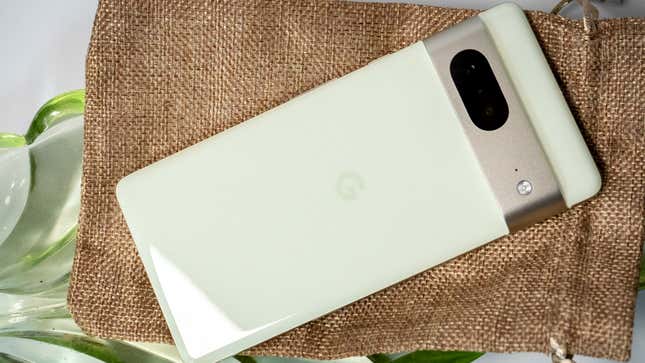
I am happy to report that the Pixel 7 and 7 Pro have face unlock added back to their repertoire, joining the in-display fingerprint scanner and the other three unlocking mechanisms Android offers by default. Face unlock is a feature that has been missing from Pixel smartphones since the Pixel 4 debuted, which uses Soli radars to recognize your face.
The downside to getting the face unlocking feature back is that it’s not as robust as Apple’s Face ID. You can’t use it to approve Google Play Store purchases, for instance, or unlock your bank account through another app. You’ll still have to use fingerprint unlock for those instances—even for Google Pay.
I haven’t had much time to multitask with the Pixel 7 and 7 Pro to see how Face Unlocking works when things are hectic. That tends to be the real test of this technology. For instance, I’ve sung the praises of Apple’s Face ID before for its relative quickness, but I faced its limitations this past weekend while traveling across the country, wearing a mask and sunglasses. For the most part, the Pixel 7’s face-unlocking mechanism exists to ensure that it’s ready to go in the hands of its owner. At the very least, the interface shows a halo-like animation on the screen to confirm that the device has registered your face.
I’ve had less than a week to experience the true capabilities of the Pixel 7 and Pixel 7 Pro. Things are smooth so far, but I’ve had a couple of hiccups. Once, the camera app went blank on me and required a restart. The Pixel Stand 2’s software-specific features that pop up when it recognizes a Pixel also crashed on the Pixel 7 and 7 Pro.
I bring this up because I’m having a hard time forgetting that the Pixel 6 and 6 Pro seemed plagued by user complaints in the months after my initial review. This is why it’s important to revisit these devices after the launch hype! However, I’m not suggesting that the Pixel 7 will be wrought with the same issues. Here’s to hoping the hiccups I encountered were all just pre-release software jitters.
Google has equipped the Pixel 7 and Pixel 7 Pro with its second-generation Tensor CPU. The Tensor G2 has a 2.85 GHz Dual Cortex X1 as the “big CPU” cores, a 2.35 GHz Dual Cortex A78 for the “medium CPU cores,” and a 1.8 GHz Quad Cortex A55 for its “small CPU” cores. The GPU in this configuration is an ARM Mali G710 MP07, and the TPU—or Tensor Processing Unit—inside is Google’s custom-made chip. Google also infused its Titan M2 security chip into the package for on-device encryption. As an aside, the Tensor G2 is a 5nm chip, not a 4nm, as rumors speculated.
One thing to note about this chip: it’s hard to compare it directly to Qualcomm’s Snapdragon 8/8+ Gen 1 because it’s not an apples-to-apples comparison. Google’s Tensor chip is more focused on neural processing, which is how it facilitates all of the Pixel’s AI smarts—and why Google says some Android devices aren’t compatible with the features. As a result, the usual synthetic benchmark suites don’t quite pan out so well for Google’s Pixel.
For example, in our Geekbench tests, which I had to sideload because the Play Store said the app wasn’t compatible with the new Pixel devices, the Pixel 7’s results were similar to the budget-priced Pixel 6a’s for the single-core score, and only about 600 points better in the multi-core ranking. The OnePlus 10T scored better overall than the Pixel 7 family, while the Samsung Galaxy Z Fold 4, which has the Snapdragon 8+ Gen 1 as its chipset, outpaced it by about 250 points in the single-core score. If you were to look at our scores for the iPhone 14 Pro with its A16 Bionic chip, the Pixel 7’s Tensor G2 numbers are even more dismal.
The good news is that the Pixel 7 and 7 Pro don’t perform in the hand as their numbers indicate they would. They are both zippy and fast, and I had no problem switching between the camera shortcut and Pokemon Go’s AR mode in rapid succession. But again, I’ve had these devices for less than a week. Let me get back to you in a couple of months, and I’ll let you know how it’s going.
One last thing to note when deciding between the Pixel 7 and 7 Pro: they have different memory configurations. The Pixel 7 has 8GB of RAM, while the 7 Pro comes with 12GB of RAM. If you’re into serious mobile gaming, especially AR-heavy titles, more memory might pan out better in the long term. Regardless of which model you choose, be sure to get the storage configuration that suits your needs. The Pixel 7 has 128 and 256GB of storage, while the 7 Pro tops out at 512GB. And no, folks, there are no SD slots here. They’ve become less common on Android devices in recent years.
Google Pixel 7 Battery
The Pixel battery’s lofty promise.

The Pixel 7 and 7 Pro also have different-sized batteries. The Pixel 7 is a 4,355 mAh battery pack, while the Pixel 7 Pro has a 5,000 mAh battery, the same as this year’s Samsung Galaxy S22 Ultra and the OnePlus 10 Pro. Google promises “beyond 24-hour battery life” on both devices, despite the differences in size, or “up to 72-hour battery life” on Extreme Battery Saver mode, which you can toggle on from the device settings.
Unfortunately for you, dear reader, I am still testing the efficacy of these claims. I hope to have an update as positive as I did on the iPhone 14 Pro’s battery capacity, which also took me some time to test. The iPhone 14 Pro models lasted over 22 hours in our battery rundown test. The Pixel 7 and 7 Pro have to beat those numbers to be the best.
Google Pixel 7 Camera
It still has one of the best cameras around.
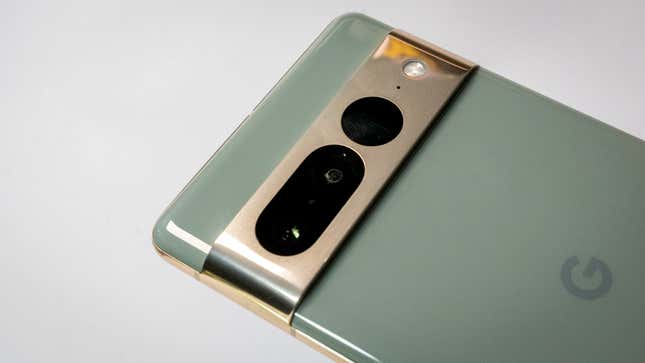
It wasn’t easy to curate the photos I wanted to share in this review. Overall, the best images the Pixel 7 Pro took were of my daughter out on a bright and sunny day. But that’s too many photos to try and blur her face out of, so let’s look at pictures of an afternoon romp around San Francisco instead. Note that the images have been compressed, so what you’re seeing here is not the full-resolution experience.


I mainly focused my testing on the 7 Pro because of its extra camera sensor. The Pixel 7 and 7 Pro have similar camera systems, including a 50-MP sensor and a 12-megapixel ultrawide camera, though the Pixel 7 has a 114-degree field of view while the 7 Pro has a slightly larger 125.8-degree field of view. The 7 Pro also has a third 48-MP sensor to facilitate its Super Res Zoom, which enables the 30x digital zoom on the Pixel 7 Pro. It’s up to 8x on the Pixel 7, though the primary camera sensor allows that. Both devices have the same 10.8-MP front-facing camera with a fixed lens and a 92.8-degree field of view.

We’ve already established the Pixel 7/7 Pro takes fantastic daytime shots, so let’s talk about this Super Res Zoom. It’s supposed to be the most effective on the Pixel 7 Pro because it has the glass and the AI smarts to manage shooting at a long distance. The feature will immediately kick in between the 2.5x and 5x zooms and after 10x zoom on the Pro’s dedicated telephoto lens. The Pro also boasts Zoom Stabilization, which didn’t always work for my shakey hands. While I managed to take clear photos of the windmills outside my backyard, which are miles and miles away, I had difficulty positioning the phone to get a sharp shot. It’s not easy achieving that kind of stability without a tripod in tow. It was even harder to try to shoot something at night.

The telephoto lens on the 7 Pro is most useful when attempting to frame a cropped photo. I found it especially helpful on a walk around my neighborhood, where I snapped pictures of the Halloween decor that neighbors had put up. The telephoto lens made it so that I didn’t have to cross the street to get a closer look and could crop in to achieve more detail. Because of its lack of a dedicated zoom lens, you don’t have this kind of malleability with the Pixel 7. If you’re a frequent concertgoer, or maybe you’re constantly shooting photos for archiving purposes, you’ll want to consider paying for that third telephoto.
Night Sight on the Pixel 7 and 7 Pro remains unparalleled, even if Apple’s algorithm has improved. Google shortened the time that the shutter has to stay open to grab light data—anywhere from three to six seconds. Of course, the Pixel is still way more aggressive at lighting up a scene than the iPhone 14 Pro. Still, I found the Pixel 7 Pro and iPhone 14 Pro Max’s night photos nearly indistinguishable except for toning.

Lastly, I want to mention Pixel 7’s new Cinematic Blur video mode—that’s all it is. It’s a bokeh-style blurring effect for the video that engages once you tap your focus on the screen. So far, it seems like a video version of the Pixel’s Portrait Mode effect and not a direct competition against the iPhone’s similarly-themed Cinematic mode. I’m still figuring out how to make the best use of it.
Now that the Pixel 7 has been released, I can finally plan some time to do a major smartphone photography shootout. Stay tuned for more comparisons between the Pixel 7/7 Pro and iPhone 14/14 Pro, which I know is what you’re all here for.
Part of Google’s ploy to get you to choose the Pixel smartphone over its numerous OEM partners is what Google deems its “Pixel drops.” The company releases software updates just for Pixel devices, and they’re typically AI-enabled features that are only compatible with what’s inside Pixel hardware.
The Pixel 7 is the debut of several new camera features, including Photo Unblur. There’s also a unique ability in the Pixel’s dialer app called Direct My Call, which helps you skip through the menu when you’re on the line with customer service, facilitated by Google’s Duplex technology. And if you use the Android Messages app to send voice memos, Google will automatically transcribe them. The Pixel 7 is also the first to get the Assistant’s Quick Phrases, which makes it easier to send commands without the opening line of “Hey Google.” I wish Google brought this to my smart speakers first—the ones I’ve already lined my entire house with.
Some of these abilities will make it to older Pixel smartphones, though it’s not always clear which ones will get them. For now, the only way to use these abilities is to buy a new Google Pixel 7 or Pixel 7 Pro.
It’s worth noting that these software features aren’t required to have a strong Android experience. They’re simply perks that Google is offering to differentiate itself from, well, Samsung, which also has its list of exclusive features only available to users of its devices and peripherals. As I said, Android is still very fragmented. It just looks a little different than it used to.
Google Pixel 7 Price & Availability
Pixel 7 or Pixel 7 Pro?
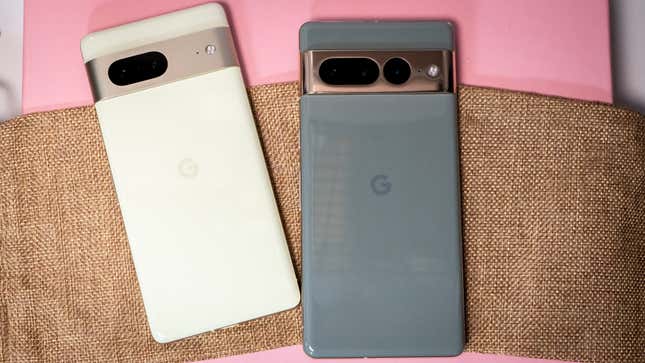
When I initially sought to review the Pixel 7 and 7 Pro, I selfishly made it about myself and my next phone purchase. I’ve been away from the Pixel family for a few years as I refamiliarized myself with other Android brands. This year, I want to come back, mainly because the camera experience remains unparalleled by the other players on this platform.
Still, I am a little disheartened by the fact that there is a difference between Google’s Android and everyone else’s, especially regarding those AI-infused features. I suppose Google has to prop itself up in some way. But if you’re considering a Pixel device, don’t do it because of the software abilities. The camera is the Pixel’s strongest feature, even without all the ways you can unblur a photo and remove someone from the background.
If you’d like to know which Pixel I’m adopting, it’s the Pixel 7. First, that Lemongrass color is adorable in person—pictures cannot do it justice. I also realized I wanted a smaller device that didn’t feel like I had to force a small handbag to close over it. The 8GB of RAM and 90Hz refresh rate also aren’t a drastic drop down from the Pro’s 12GB and 120Hz refresh rate, and it’s a whole $300 cheaper.
